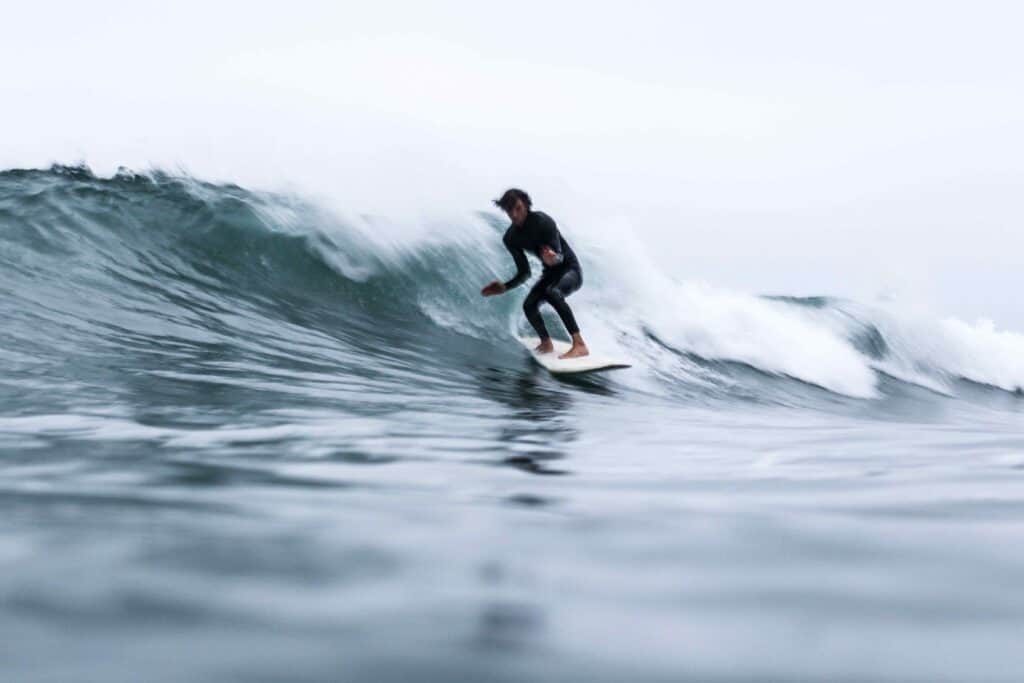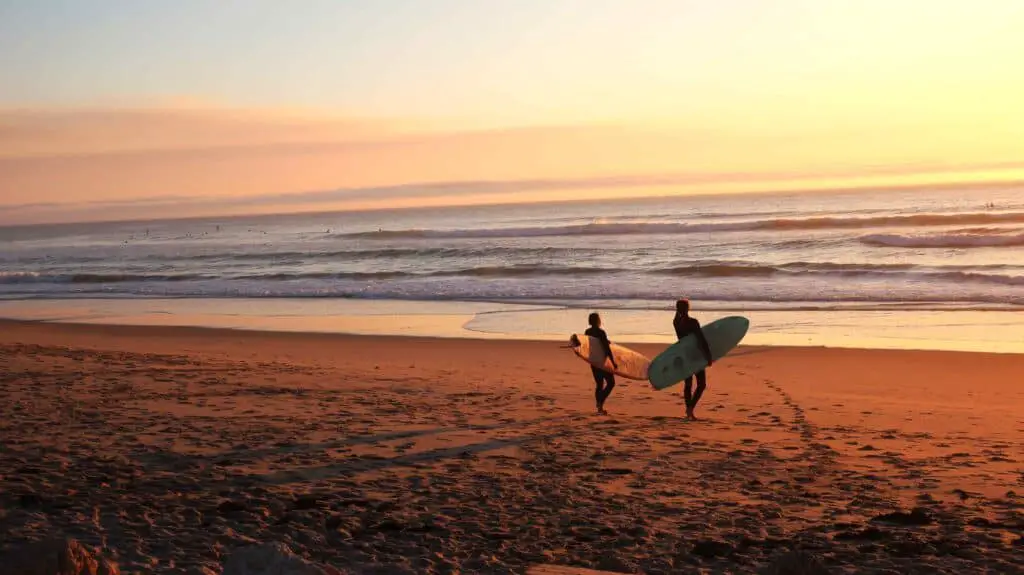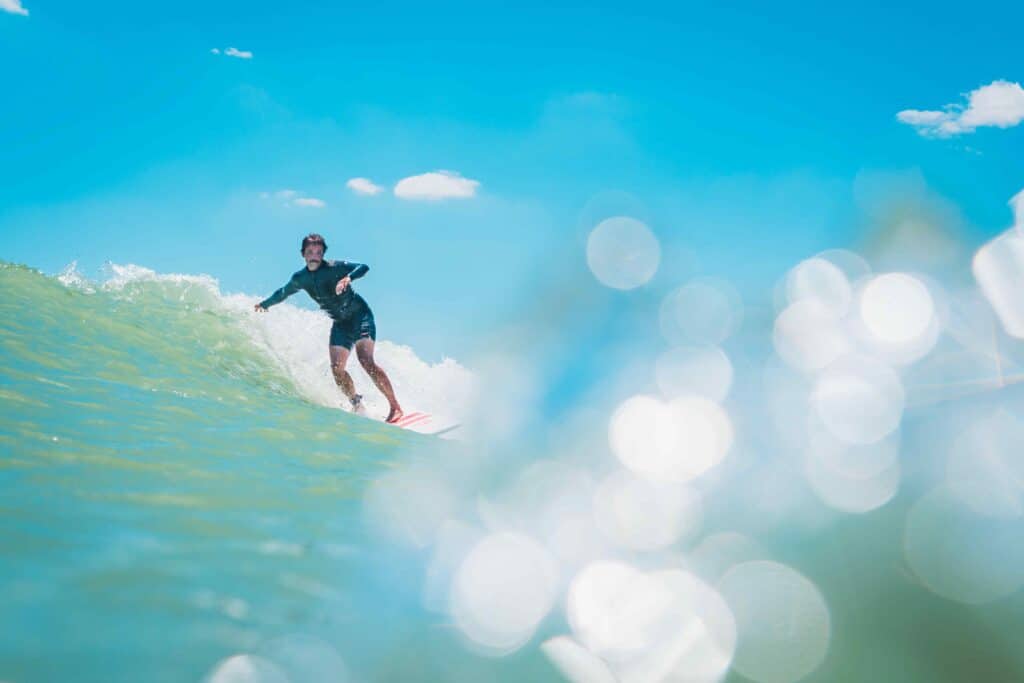
If you’ve found this article, it’s safe to say that you’re thinking about taking the plunge and you want to know how hard is it to learn to surf. Well, to put it simply – learning to surf is quite difficult. However like all challenges, if you put in the effort you will benefit from learning a new skill and the joy that surfing will bring you will be well worth the journey. This article looks at the key difficulties that most people face when learning to surf.
The benefits of surfing
Firstly, we can’t talk about what makes surfing hard to learn without at least highlighting what is so good about surfing! These listed benefits below are only some of the positives that you will get from surfing and why you really should give it a go.
1. Physical health benefits
The physical benefits of surfing are quite obvious, but perhaps the most unique thing about surfing is that it involves almost all areas of the body and a combination of strength and cardio fitness.
Starting on the beach and there’s the initial act of carrying a surfboard to the water which involves upper body strength and depending on the distance you need to walk to get into the ocean this can add up. From there getting out to the waves and throughout a whole surf session, surfing involves a lot of paddling. This is the most physically demanding aspect of surfing and involves considerable work on the shoulders, arm, core and upper back. Arching the back and paddling with a high level of control is tough work and a great work out, similar to swimming.
When you are up and surfing on your legs, there is a lot of physical work for the legs in terms of balance and control of the surfboard.
2. Mental health benefits
On top of the physical benefits of surfing, there are many factors which positively impact the mind. Firstly, the act of doing something active and connecting with nature and the ocean is something that provides a major boost for your mindset. Many people vouch that their daily surf is a cleansing experience and a way to reset and recharge.
Another aspect of surfing is the way that it will make you forget about everything in those moments you are catching a wave with utmost concentration. There are not many activities which will cause you to completely disconnect from external thoughts and that’s pretty special.
3. Patience
Surfing teaches us to be patient in different ways. Firstly, in learning to surf we need to be patient as we work on the skills and put in the work to become better at surfing. Furthermore, through the pursuit of surfing waves we are required to be patient in waiting for the right surfing conditions (the waves are not good every day!), waiting between sets for waves and for our turn in crowded conditions where the competition for each wave increases. Some of these may seem like negatives, but becoming a more patient person in the modern world that we live in, is very important.

4. Balance and coordination
As you learn to surf, the balance and coordination skills associated with surfing are transferable to other activities and sports.
5. Fun
Fundamentally, surfing is just plain fun. When you catch a wave, whether it’s a screaming barrell or tiny waist high peeling wave, you won’t be able to wipe that grin off your face. Only a surfer knows the feeling – is a saying you often hear. That feeling of pure fun is something that surfers are constantly looking for and will keep going back for. As they say once you catch your first proper wave, you will be hooked.
6. Social
Surfing is unique because it can be very social, but you can also surf alone. On the social side, there’s something amazing about sharing waves with some close friends and being able to recount stories later on. The more we surf, the more we tend to make friendships with other surfers and personally some of my greatest friends are those that I’ve met and bonded with through surfing.
Key challenges which make surfing hard to learn
Now that we’ve considered the benefits of surfing, we will look at the aspects which make surfing hard to learn. Some people take to surfing very easily – but on the most part, a lot of people have to go through the process of being a learner and progressing.
We believe the following areas are where the majority of people face difficulties in learning to surf.
1. Swimming
Confident swimming is probably the cornerstone of surfing and if you aren’t able to swim proficiently in open water then you will have a hard time learning to surf. You could say it’s possible to surf in shallow water without needing to properly swim but I’d say there aren’t many skilled surfers who can’t swim well.
2. Gaining control of the board (balance and coordination)
Once you’ve mastered riding a surfboard in the whitewater on your stomach the next logical step is to start popping up to a standing position. This is where many have trouble and the difficulty lies in the fact that you’re trying to stand on a moving surfboard that is never perfectly stable and on waves that you have no control over.
Some people get used to this faster than others, but it comes down to repetition and focusing on keeping your gravity low (knees slightly bent) and feet an appropriate distance apart.
The other thing that learners can have trouble with is general manoeuvring of the surfboard in the water. Whether this be climbing back onto the board and getting into the right position on the board for paddling, or turning the board into the right direction and position to catch the wave. This is especially difficult when trying to handle an 8 or 9 foot surfboard for the first time. Again, these kinds of things get easier with practice and time.

3. Surfboard selection
The debate over long and short surfboards has gone on since shorter boards started to gain huge popularity from the 70’s – 90’s. While it is certainly possible to learn on a shortboard, the vast majority of beginner surfers will be doing themselves a favour by jumping on a longer surfboard with higher volume.
High volume is a function of length, width and thickness of a surfboard and fundamentally it means more float. Longer boards are forgiving and you won’t fall off as easily.
Some learners trying to pick up the art of surfing on a shortboard find it really hard to progress and that’s simply because shortboards are harder to surf!
With appropriate beginner surfboards, progressing from the initial beginner stages is a whole lot easier and from there, you can transition to shorter boards.
4. Finding the right waves to learn on
It’s difficult to learn to surf in inappropriate surfing conditions and waves that aren’t user friendly. There are many different types of surf breaks such as point breaks, beach breaks and reef breaks to name a few and the dynamics of all these waves are a whole lot for a beginner to get their head around.
Not only that, all of these types of surf breaks can be suitable for learners at certain times – depending on the low or high tide, swell direction and wave heights which can change completely from one day to the next. How is someone new to the sport going to figure all this stuff out and work out where they should be surfing in their local area on any given day? The dynamics of surf breaks do make surfing hard to learn.
5. Getting a sense and understanding for waves
Separate to the actual surf spot are the different ways that waves can break, and developing an understanding of where you need to be and what part of the wave to catch it and to surf it is tricky. As an absolute beginner, finding a spot where there is a good crumbling wave and white water suitable to learn entry level surfing skills is not so easy either.
On a basic level, learning about how waves work is something that you will learn naturally in time and with experience in different conditions.
6. Committing enough time
One thing that people may find challenging to successfully learn to surf is the amount of time they need to dedicate to it. Unless you’re a complete natural, it’s unlikely that you will pick up surfing within a few hours. It’s the kind of thing that you ideally need to spend a few weeks of daily surfing or lessons to really pick up the fundamentals. Failing that, if you are able to surf at least every week or so at least you can maintain some regularity in the water.
Unfortunately if you can only get into the water every so often or a couple of times a year on holiday – it’s going to be quite hard to get past the real beginner stage of learning to surf.
The truth is surfing is a long and never ending journey for most. We’re all trying to improve no matter what stage we’re at and that never stops even after decades of surfing. It’s all about the long game.
7. Setting realistic expectations
Some people get frustrated with slow progress in surfing, and this may be because most of what we see in surf media is of professional surfers who make it look so easy. The idea of struggling on a long beginner board may wear off fast to someone who has an idea in their head of surfing like Kelly Slater within a few weeks.
It’s important to set realistic expectations for your surfing when you are starting out and realise that everybody started in the same spot (well, almost everybody). Also, to remember to not take it too seriously, after all surfing is supposed to be fun.
8. Self taught vs surf lessons
The last thing that people may find hard in their early surfing stages is being self taught and trying to learn on their own. By all means, you can teach yourself to surf and pick up the early skills. However, you may really short cut the process by taking some surf lessons. A surf instructor will be able to correct any ineffective techniques that you may be using to begin with, which will otherwise stick with you as you try to progress your surfing.
Without proper guidance from a surf instructor or an experienced surfer to guide you, you may find that you are running into many of the difficulties that we’ve highlighted in the above points 1 – 7.
The Wrap up
So how hard is it to learn to surf? It can be easier for some people and harder for others, as everyone is different, however it certainly won’t be a walk in the park. But that shouldn’t stop you getting out there and giving it a go! Once you get that first proper wave, no matter how you catch it and how silly you may look – you’ll be smiling from ear to ear and you’ll be paddling straight back out for another one.
